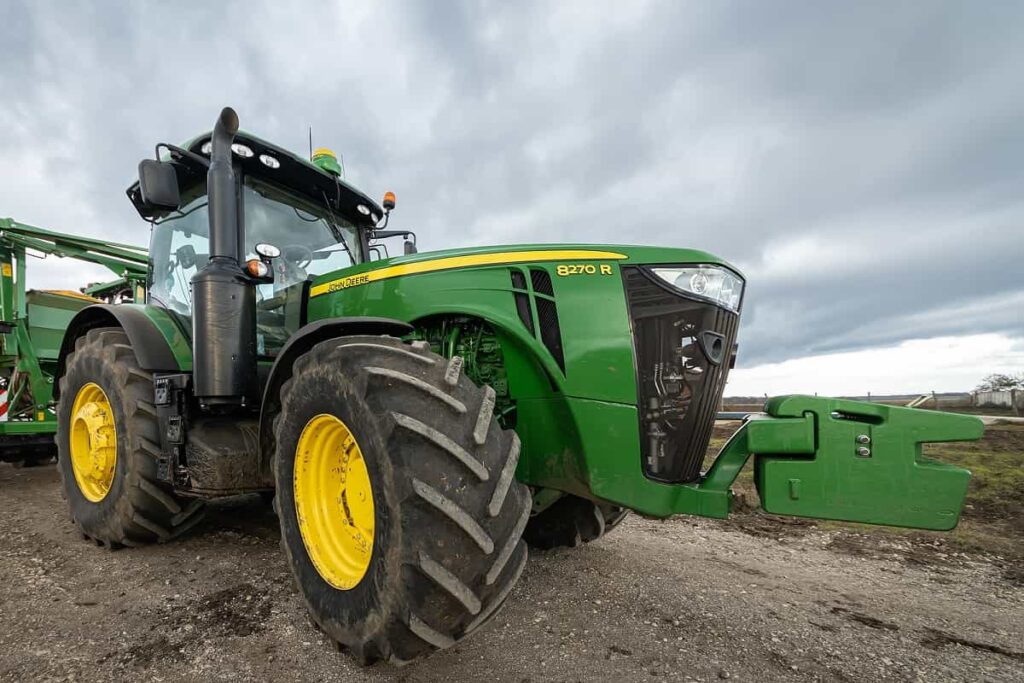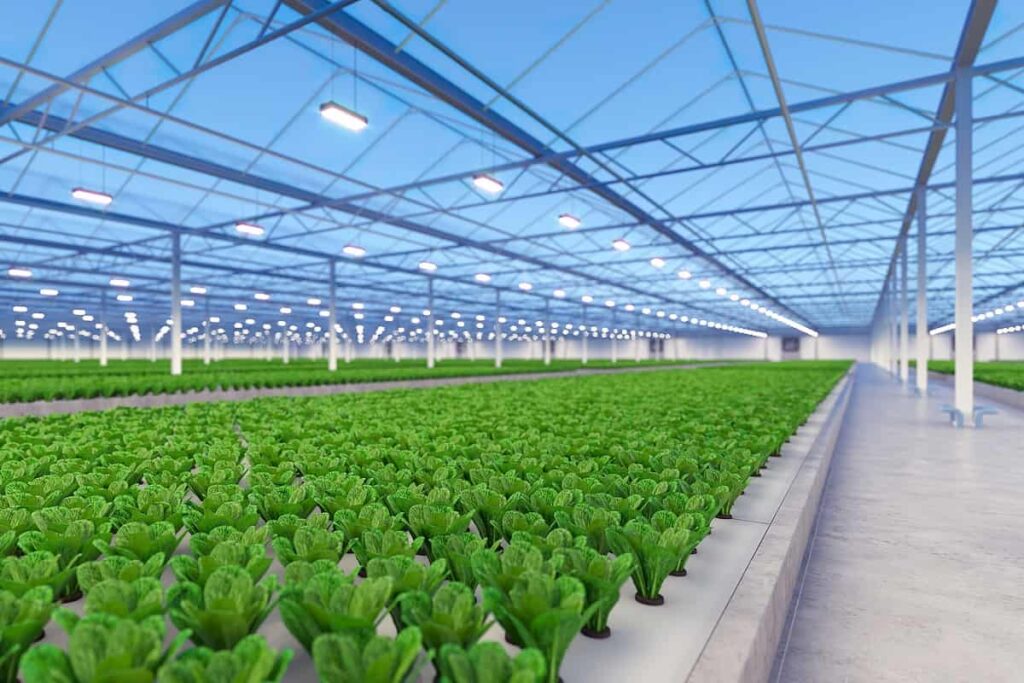Vertical Farming Companies See Funding Drought
Table of contents
Table of contents
- What is Vertical Farming?
- Indoor Vertical Farming Companies Grow Up
- Improved Genetics for Indoor Vertical Farms
- High-Tech Greenhouses for Year-Round Produce
- Blockchain for Indoor Vertical Farming
- Vertical Container Farms for Growing Weed
- Growing Plants Out of Thin Air
- AI for Indoor Vertical Farming
- Conclusion

Nanalyze has largely avoided playing the pandemic clickbait game, but there’s no denying that the novel coronavirus has changed the rules in terms of what’s hot and what’s not. While the stock market has been mostly detached from reality, there is some logic behind the rise and fall of certain sectors of the economy in light of the “new normal.” Healthcare is an obvious winner, where medical robots and technologies like virtual reality telemedicine are getting a chance to prove their value. On the losing end are industries like hospitality, which needs to adopt more contactless solutions for travelers to survive. Another hard-hit sector is the restaurant industry, which until this year accounted for more than half of all food dollars spent in the United States. No more. People aren’t dropping money for lobster dinners, with spending away from home at levels not seen in more than a decade:

On the flip side, food dollars are flowing into groceries stores instead. So you’d think that investors would be pouring even more money into trendy indoor vertical farming companies. Not so much. AgFunder’s mid-year investment report on everything agtech found novel farming startups had raised only $105 million in the first six months of 2020, compared to more than $700 million last year. Novel farming systems, by AgFunder’s definition, include not just indoor farms but companies that grow bugs for food, run high-tech aquaculture operations, or produce alternative proteins like algae.
What is Vertical Farming?
Indoor vertical farms, container farms, high-tech hydroponic chambers – whatever you want to call them – dominate the novel farming category. While there are variations to the theme, the general argument in favor of growing crops indoors is a green one. These operations can save tons of water (usually 90% or more over conventional farms) while relocating food production to dense urban areas in case there’s another run on toilet paper. Technology is at the forefront, with sensors for monitoring environmental conditions and artificial intelligence (or some type of sophisticated software) automating as much of the process as possible (less infectious humans to worry about). That enables these farms to grow more plants – stacked warehouse-style – per square foot than Farmer Fred.
Critics point out that there are some unsightly weeds. Most of these indoor farms are pretty power hungry, though many companies are trying to go green by switching to solar or wind energy. Dense urban areas usually tend to command high rents, especially in the cities where many of these companies are based like San Francisco and New York. We’ve also questioned the economics of some of these container farm operations like Freight Farms, which raised $15 million earlier this year.
Indoor Vertical Farming Companies Grow Up
None of that has stopped the nascent industry from attracting its share of mega-rounds, beginning back in 2017 when San Francisco-based Plenty reaped a $200 million Series B led by free-spending SoftBank. The company raised a $175 million Series C last year (that for some reason didn’t make into the 2019 AgFunder tally), bringing total funding to $401 million. Plenty recently announced what has to be the biggest deal in its six-year history when it signed an agreement with the Albertsons grocery chain to sell its high-tech hipster greens at 430 California stores.
Update 01/27/2022: Plenty has raised $400 million in Series E funding to make fresh, clean produce more accessible and affordable. This brings the company’s total funding to more than $941 million to date.
Another well-funded indoor vertical farming company, AeroFarms from Jersey that basically uses moist air to grow plants, took in $100 million last year to bring disclosed funding up to $238 million. That doesn’t include the slice of a $100 million investment that the Abu Dhabi government made into four agtech companies including AeroFarms back in April. In return, AeroFarms is constructing a 90,000-square-foot indoor vertical farm in the UAE capital that it claims will be the world’s largest of its kind.
A third deep-pocketed startup, New Yawk-based Bowery Farming, grabbed a quick $50 million in 2019 for a total of $167.5 million. Not far behind is InFarm, a startup in Berlin that has raised about $134.5 million following a $100 million round last year, though the Financial Times reported that the German company raked in another $140 million this past June, with another $60 million to go. InFarm operates a slightly different business model by locating its modular indoor vertical farms at grocery stores to sell hyper-local produce.
This year’s investments into indoor vertical farming and other novel farming systems have been pretty modest in comparison, aside from the unofficial $200 million Series C in progress from InFarm.

In the remainder of the article, we’ll take a look at the indoor vertical farming companies we haven’t covered previously that have raised money this year.
Update 12/16/2021: Infarm has raised $200 million in Series D funding to support their rapid global expansion and bolster their R&D so that they can grow more varieties of crops. This brings the company’s total funding to $604.5 million to date.
Improved Genetics for Indoor Vertical Farms
We’ll actually start with a company that’s not on the above list and is not actually designing indoor vertical farms – Unfold. Founded just this month, the startup is something of a joint venture between Bayer and Singapore-based investment firm Temasek, which is also an investor in Bowery Farming. The duo have sunk $30 million into the brand-new company, which will be dedicated to developing better seed genetics specifically for the indoor farming industry. Bayer brings to bear intellectual property around germplasm, the genetic material that it can use to design plants that are grown in underground bunkers.
High-Tech Greenhouses for Year-Round Produce
Next up is the most well-funded of this bunch, AppHarvest, which actually took in two separate rounds this year including a $28 million Series C this month after hauling in $11 million back in January. Founded in 2017, the Appalachia startup has reportedly raised about $150 million total for high-tech greenhouses that operate year-round. Some big names are attached to the company, including a venture capital firm headed by author J.D. Vance with financial backing from the likes of Peter Thiel and Marc Andreessen. And, oh, Martha Stewart sits on the company’s board.

AppHarvest’s controlled-environment facility is designed with the ESG-types in mind. For instance, it uses a hybrid LED lighting system that is 40% more efficient than typical lighting and also helps reduce natural gas usage in cooler months. A 10-acre rainwater retention pond at its Kentucky farm completely eliminates agricultural runoff, the cause of toxic algae blooms.
Another riff on the high-tech greenhouse comes from Pure Harvest Smart Farms, a four-year-old startup in Abu Dhabi that is attempting to mine spice on Arrakis to establish food oases in the Arabian desert. The company has raised nearly $30 million, with most of the money coming back in April from a $20.6 million Series A led by a Kuwaiti investment firm that has pledged up to $100 million to Pure Harvest.

The hydroponic greenhouse is climate controlled to mimic a Mediterranean climate. It uses sensors to monitor everything but still relies on low-tech bumblebees for pollination.
Blockchain for Indoor Vertical Farming
Blockchain for broccoli? Why not? Founded in 2018, Toronto-based Elevate Farms has raised $11.8 million over two rounds this year. A $10 million Series A in May is part of a 10-year deal to deploy its indoor vertical farms to the remote corners of northern Canada where people reportedly eat moose and flying squirrels. The company claims to use 99% less land and water than traditional agriculture, as well as 80% less labor, while producing 125 pounds of plants per square foot.

The company also says it uses blockchain technology to track and trace its products from seed to shelf, because that’s super important to people who haven’t seen fresh fruit in six months.
Vertical Container Farms for Growing Weed
Thanks to Agrify out of the Boston area we don’t have to leave off America’s cash crop from this list. Founded in 2016, the startup raised $4.5 million at the start of the year. Agrify offers several products, including a vertical farming unit (VFU) with built-in lighting, irrigation, and temperature controls, along with modular catwalks that allow ganjapreneurs to grow weed sky high without extensively rehabbing that rundown, downtown warehouse.

Agrify also does self-contained farms in 40-foot shipping containers, complete with climate control, irrigation and fertigation, and high-performance LED grow lights, all controlled and monitored by its proprietary Agrify Insights software platform.
Growing Plants Out of Thin Air
Indoor vertical farming companies seem to be in a contest to see who can use the least amount of water to grow microgreens for hipsters to put on their avocado toast. Founded in 2015, UK-based LettUS Grow has raised about $4.5 million to continue to develop its aeroponic technology. Like hydroponics, aeroponics does not use soil but employs nutrient-rich water to grow its plants. In a hydroponics system, a plant’s roots come in direct contact with the water while aeroponic systems rely on mist. Like Agrify, LettUS Grow offers its aeroponics systems in stackable tiers or as a plug-and-play modular farm. It also has its own farm management software solution, Ostara, which collects data and automates much of the growing process.

Another UK startup, Vertical Future, founded in 2016 and backed by $6.7 million, offers a hybrid system that can switch between hydroponic and aeroponic modes. It also has a software solution, called DIANA, which makes adjustments to the growing conditions to optimize yield. The company reportedly has a nearly $6 million deal to roll out its vertical farming system “across various locations” over the coming decade.
AI for Indoor Vertical Farming
Many agtech startups claim to use artificial intelligence in some form or fashion. But AI is central to iFarm out of Finland. Founded in 2017, the company has raised $4 million. Its Growtune platform leverages computer vision, machine learning, and data about thousands of plants collected from a distributed network of farms. It can determine the plant’s weight, any growth deviations or pathologies, and then build a system that improves a crop’s quality characteristics on its own. It also provides recommendations to the farm staff and adjusts the microclimate settings to ensure better results.

The Finnish startup also develops indoor vertical farms, with 11 industrial facilities in operation or under construction in Finland, Switzerland, the UK, Netherlands, Andorra, Russia, and even Kazakhstan.
Conclusion
And we’re still not done. We haven’t even told you about AmplifiedAg out of Charleston, South Carolina or AgroUrbana in Santiago, Chile. Both startups have raised $1 million each and offer some variation of indoor vertical farming technology. But you probably get the idea by now: Indoor farming has taken root around the world. It’s another one of those emerging technologies that may experience a degree of acceleration thanks to the hoarding mentality supply chain challenges in a world still adjusting to the “new normal.”
While the big bucks may not be in play like they were the last few years for indoor vertical farming companies, that may be more a result of there being so many startups vying for limited dollars. Not to mention the fact that there’s easily been more than $1 billion deployed in the market since at least 2017. Investors are likely looking to reap some of their own green before they commit more dollars.
Sign up to our newsletter to get more of our great research delivered straight to your inbox!
Nanalyze Weekly includes useful insights written by our team of underpaid MBAs, research on new disruptive technology stocks flying under the radar, and summaries of our recent research. Always 100% free.


























Hi nanalyze team
Would like to point out that on your list many companies are missing that operate without Silicon Valley noise below the radar quite successfully. One of them is &ever, formerly Farmers Cut operating since January a large farm in Kuwait. &ever is the only farm in the world with identical climate on any layer including identical values for CO2. The local demand is exceeding supply and we are profitable….
Too many believe funding levels are an indicator of technology excellence – that is not the case. We have achieved all that with a fraction of the investments of those companies you mention.
Happy to provide you with more news if you would be interested! Kind regards
Mark Korzilius
Hi Mark,
Thank you for reaching out and congratulations on your success! We were recently scouting tech startups in Kuwait and Saudi and regret not learning about your company sooner.
You are absolutely correct that funding is no indicator of success. We see this time and time again, especially outside the Silicon Valley Vatican.
Please make sure to update your information in Crunchbase as that’s how many startups get found. Also, if you can drop an email to our Managing Editor – [email protected] – he’ll see what we can do to bring you some exposure.
Thanks again for the comment!